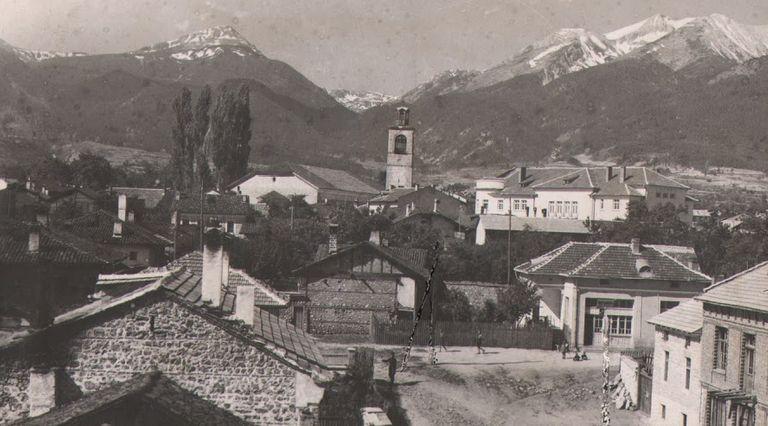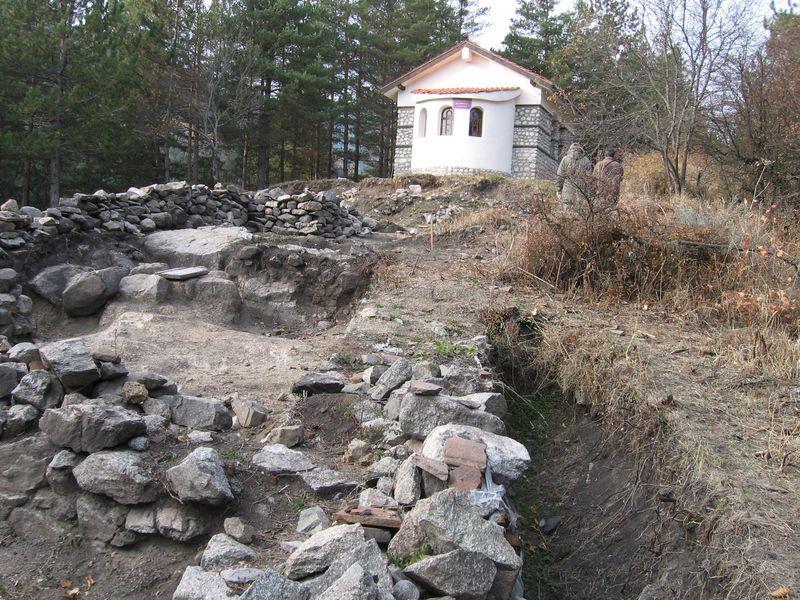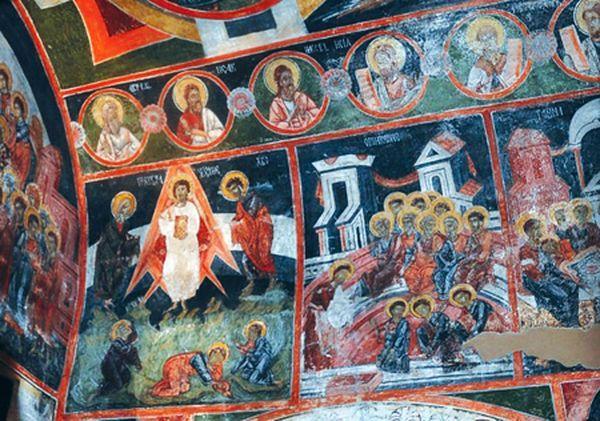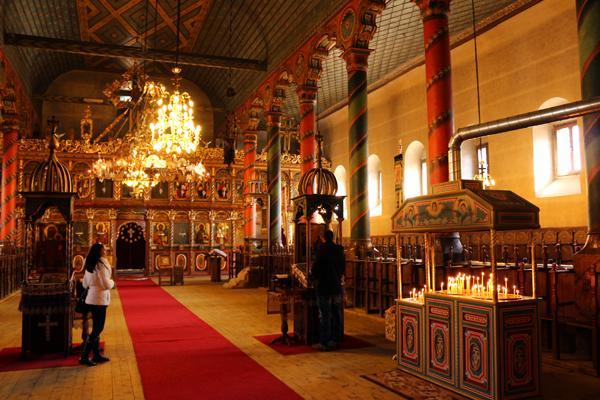Christian churches in Bansko and the region attract strong interest from tourists from all over the world. With these temples one can “read the history” of Christianity in Bulgaria from its early days (four basilicas from the 4th century are found here) to the present day.
One will see the power of faith and the Bulgarian spirit, original talents and many beautiful things.
Some of the Christian churches in Bansko and the region are unique. Such as the Holy Trinity church, for example. It was the biggest on the Balkans until Aleksandar Nevski takes the first place. But apart from this, it was related to dramatic events and tragic destinies in the name of the faith.
The church in Dobarsko with its construction and mural paintings is the only one in the world; the Dormination of the mother of God church has a unique iconostasis and so on. Thus the Christian churches in Bansko and the region offer an exciting journey through the ages.
Bansko – a centuries-old hearth of Bulgarian national spirit and Christianity
The Bulgarian national spirit and Christianity have deep roots in Bansko and have always stood steadily throughout the centuries.
Even during the long Ottoman slavery the population here has a more special status of autonomy even if tacit. In Bansko for example there has never been a konak, although the settlement – as population, as an organized social life and as an economic development – has played the role of an administrative center in the distant past.
One more fact could be mentioned. Bansko is at the foot of the Pirin Mountains and the region was favorable for the development of the basic then livelihood – agriculture and stock-breeding. There were also crafts and opportunities for trading on the Aegean coast. However, there were no massive settlements of Ottomans in the area.
All historical evidence points to Bulgarian population. American missionaries who visited Bansko in 1867 talk about Bulgarian inhabitants of between “4 and 5 thousand”. In the Ethnography issued in 1878 in Constantinople, the inhabitants of Bansko are also categorically referred to as Bulgarians.
This is later confirmed by the ethnographic and statistical work of Vasil Kanchov – he emphasizes that in 1900 the population of Bansko is of 6,500 Bulgarians, who profess Christianity.
On this background, it can also be mentioned that when a forcible adopting of Mohammedanism began in the 17th century in the Pirin region, the Muhammadan faith adopted by only one person in Bansko.
This preservation of the Bulgarian self-awareness in the region naturally makes Bansko one of the leading centers of the Bulgarian Renaissance to which the town gives prominent personalities. Here are Paissiy whose Slavonic-Bulgarian History is a turning point for the Bulgarian Renaissance, his brothers Lavrentiy and Hadji Valcho, Neofit Rilski, the icon-painter Toma Hadjiikonomov, Galaktion Hilendarets, many traders, haidouks and revolutionaries.
Christianity in Bansko – ever since Apostolic times
The Christian faith in Bansko and the region has spread since the first centuries after the New Age. And to such an extent that at the end of the 4th century there are already Christian churches in Bansko. Remains of two such early Christian basilicas are found 4 km from Bansko in the Sveti Nikola area.
Two other similar churches from the same time were found in the immediate vicinity of the town. One is in the area of Shipotsko – about 2 km from Bansko. The other early Christian basilica, discovered by the experts, is in the St. Ivan area at about a kilometer away from Bansko.
As one can see, churches were intensively constructed as early as 4th century A.D. in Bansko. And the Christian religious construction speaks of the pervasion of Christianity here before that. And no wonder because on nearby lands Christianity begins in the times during its history called “apostolic”.
In their study, Prof. Georgi Bakalov and Totyu Koev cited a book called Acts of Apostles according to which Apostle Paul preached Christianity in Thessaloniki and before that in Aegean Thrace. His disciples there attain broad dissemination of the word, the faith strengthens, active religious life takes place and temples are being built.
Historically, the distance from these territories to the Bansko area is relatively little. Moreover, Christianity is rapidly spreading. Indicative of its influence is that Bessi, one of the cruelest Thracian tribes, does not oppose to the sermons and even the Bible is translated into their language.
The interesting story of the Early Christian churches in Bansko
From the Early Christian Churches in Bansko, the Basilica at the upper end of the hill in the area of St. Nikola has been studied the best so far, During the excavation another one was found there, also from the 4-5 century AD but unfortunately a big part of its foundations are not preserved due to landslides.
The church at the upper end was discovered quite accidentally – in 2003 the locals cleared the area for the restoration of a chapel. This is how they came across the foundations. During the excavations it became even more interesting – the archaeologists came across a large Thracian city-fortress and discovered the second basilica.
And in the lower layers, they found traces of human activity from 4,500 to 5,000 years ago. Thus the two Christian churches in Bansko are a part of a large archaeological complex which attracts many tourists today.
The church at the top of the hill had one nave and one apse. The liturgical premise is oblong as in the early Byzantine churches and is oriented east-west. The construction was made of hearting stones with a soldering made of mortar. The temple was expanded in the Middle Ages using river round stones. Today the foundations are overlapped by the St. Nikola Chapel.
The other two Early Christian churches in Bansko – in the areas of Shipotsko and Sv. Ivan also have an intereting story. The one in Shipotsko was apparently destroyed in the 6th century by the Slavs, after the 12th century it is restored but again being destroyed by the Ottomans. The basilica itself is built on the foundations of a Thracian construction.
In the area of St. Ivan besides an early Christian church, there is a late antique workshop for construction ceramics as well as a Thracian sanctuary from 5th century BC for worshipping of fire.
The church in Dobarsko – unique in every way
The Church in Dobarsko has not been included in the World Heritage by UNESCO by accident – it is unique in every way. You can start from the construction – it was built at the beginning of the 17th century, in 1614, but at that distant time the masters have made a miracle – the church is a natural “air conditioner”.
Both during summer and winter the temperature is maintained in amplitudes that have preserved the mural paintings. Without air conditioning, without being once restored, these mural paintings have preserved for four centuries their authentic, bright colors. And that even though the temple was converted by the Ottomans into a bath in the 19th century.
The construction is unique because of something else too. At that time it was adopted that the temple space should be one-nave, however, a complex and richly decorated three-nave basilica was built here. Probably as compensation for the dull external appearance – during the Ottoman slavery Christians were obliged to sunken their temples into the ground so that Christian symbols would not rise higher than the Muslim ones.
The mural paintings are unique also in terms of theme, At a standard number of four to five images of saints in a temple, here there are 30 painted emphasizing saint warriors. In fact, the whole church is painted inside – with over 460 images on an area of 160 square meters.
It is impressive that there are many images of women – 30 saints, including also Catholic saints. This cannot be seen anywhere else.
Amazement of the visitor does not stop here, because there are mural paintings in the church – the Transfiguration of Christ, on which Christ is represented in a geometric figure that reminds a lot of a rocket that is taking off and under it the atmosphere and the stratosphere can be seen.
“The resurrection of God” represents Christ in a similar way as an astronaut –he resurrects the dead in Hell, and on the surface he appears with a capsule like the one used currently by for the astronauts to come back to Earth.
Thus, the church in Dobarsko which is 20 km away from Bansko provokes high tourist interest and special excursions are being organized to visit it. For example, the 5-star Lucky Bansko Aparthotel always includes it its tour offers.
Holy Trinity church in Bansko – the power of the Bulgarian spirit
Among the Orthodox churches in Bansko and the region particularly interesting is the Holy Trinity church located in the center of the town. It impresses not only with its size – ground floor and balconies on two floors, but also with its history that is indicative of the power of the Bulgarian spirit and faith.
The temple was built from 1833 to 1835 with the donations of 270 families, and there were many individual contributors – 1,081. The ground is also donated – the church is raised on a property given off by Lazar German, the then mayor, initiator and organizer of the construction. And Toma Hadjibena – a relative of Neofit Rilski, donated the area in front of his house.
The church is the work of local masters – construction, decoration, iconostasis, bells. The 30-meter-long bell tower raised shortly after and the clock on it were also built by masters from Bansko. Whoever could not give, worked without payment – up to 350 people worked on the construction at the same time.
There are interesting but also tragic moments related to the obtaining of permits. Negotiations with the Ottomans were led by Lazar German but it was difficult. To speed things up, he buried a cross and an icon in the planned for the construction area and told an elderly woman to have a “dream:” of what they would find there. Then, in the presence of people from the Ottoman government, they dug up and discovered the “omen”.
There were also gifts and bribes for the Ottoman nobles, all the more so that the people of Bansko started the temple with a larger size than the allowed.
When the money was finished, Lazar German borrowed 300,000 Groschen from the bey (Ottoman noble), he was trading with. However there was an investigation as to why the church is bigger and where did the money come from; after it Lazar German was thrown in prison. He didn’t resist the tortures and told about the loan which lead to the falling in disgrace of his friend the bey .
The church was going to be demolished but Lazar German had ordered with foresight to carve the Ottoman coat of arms with the half-moon and the star at the entrance next to the cross. This stopped the demolition and the church was finished but inside the dungeon Lazar German did not live in to its consecration.



